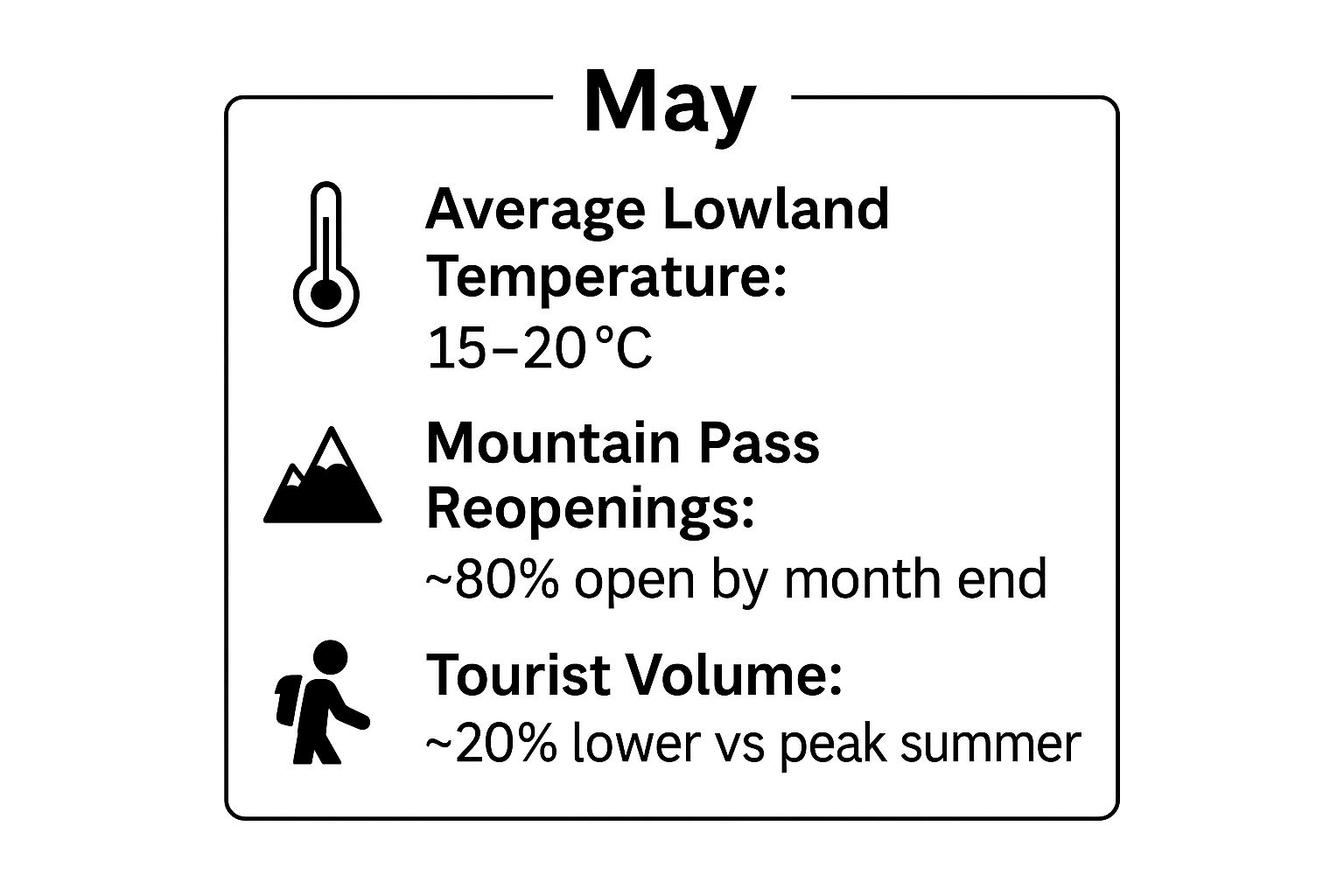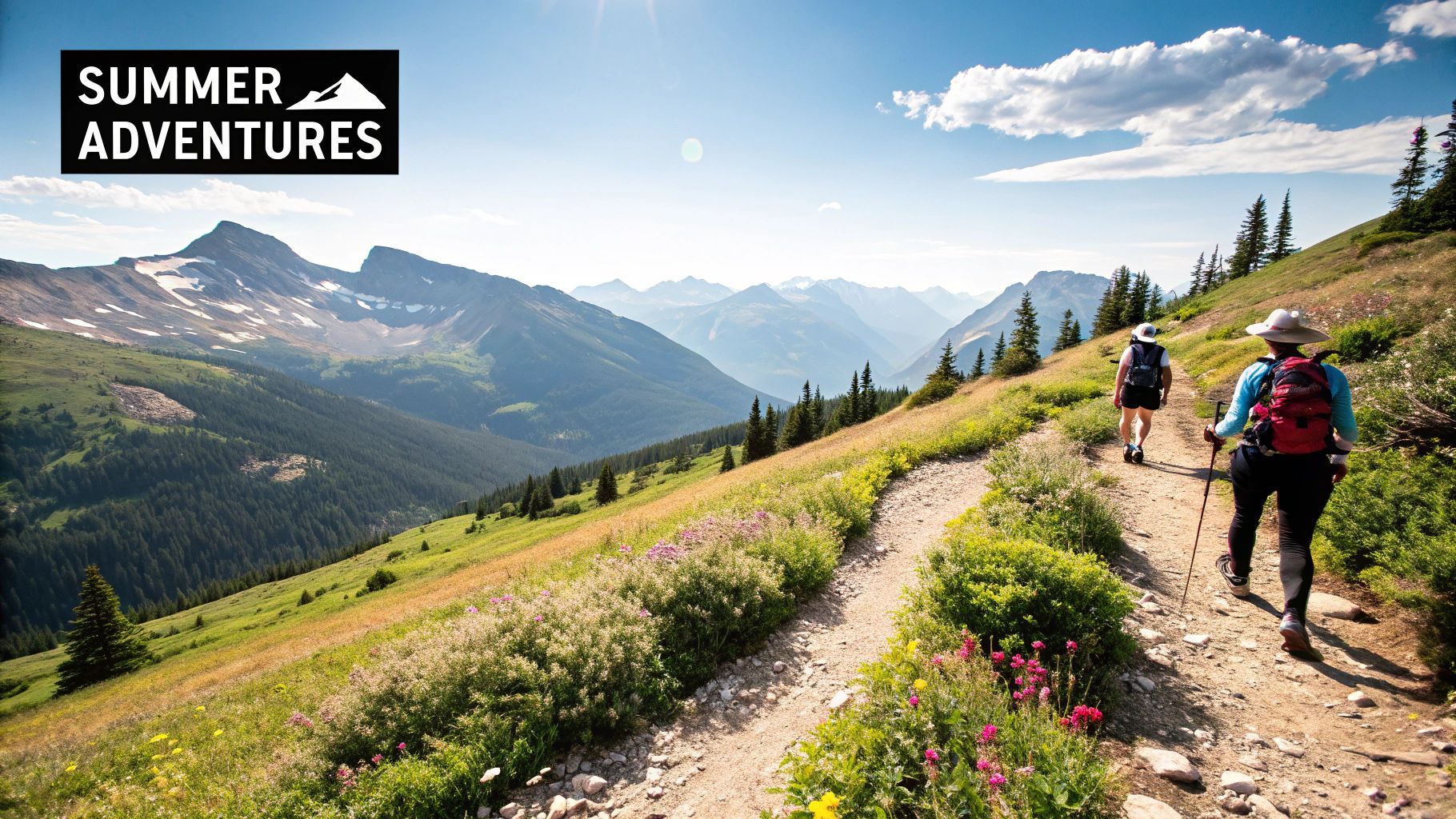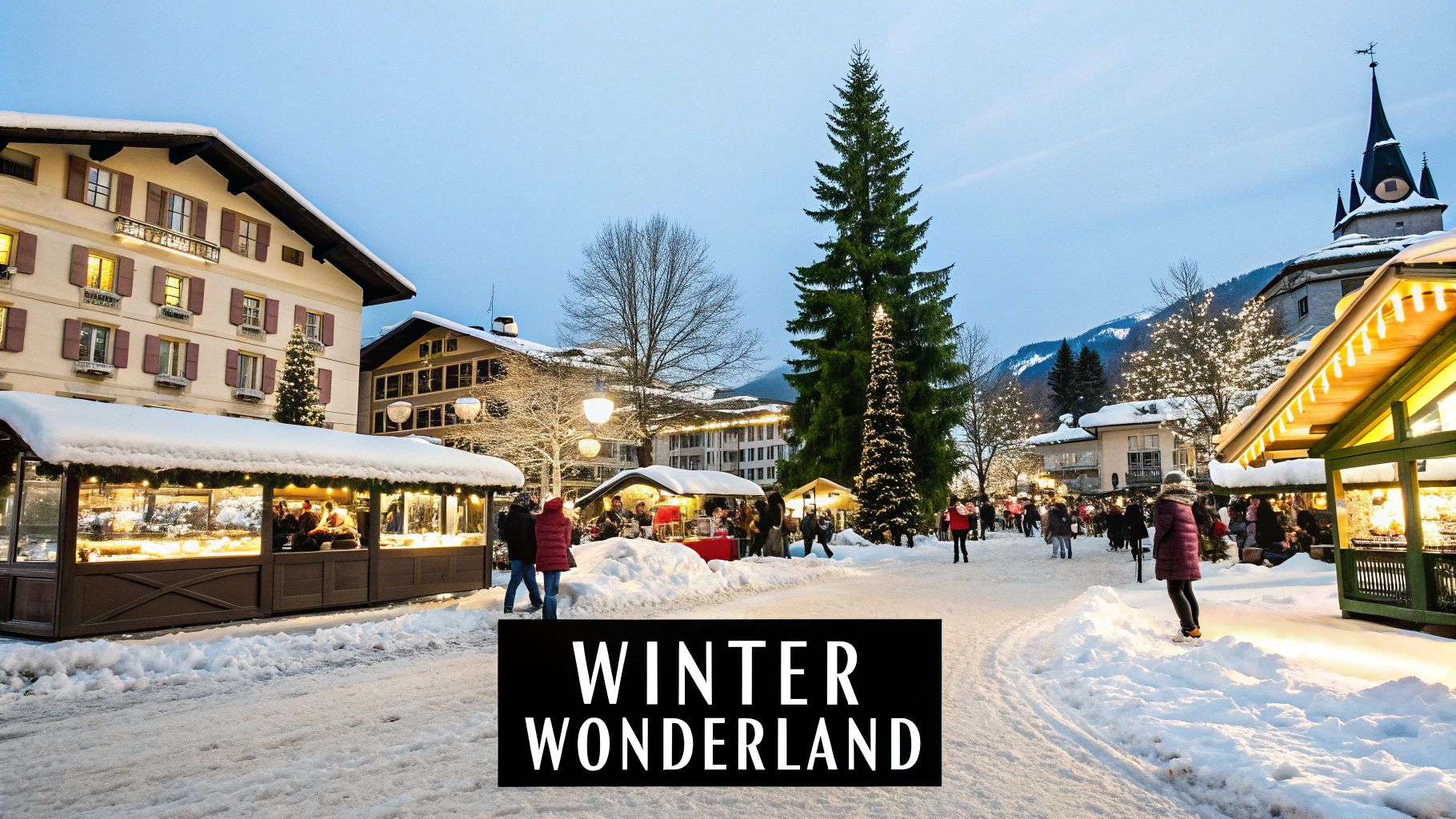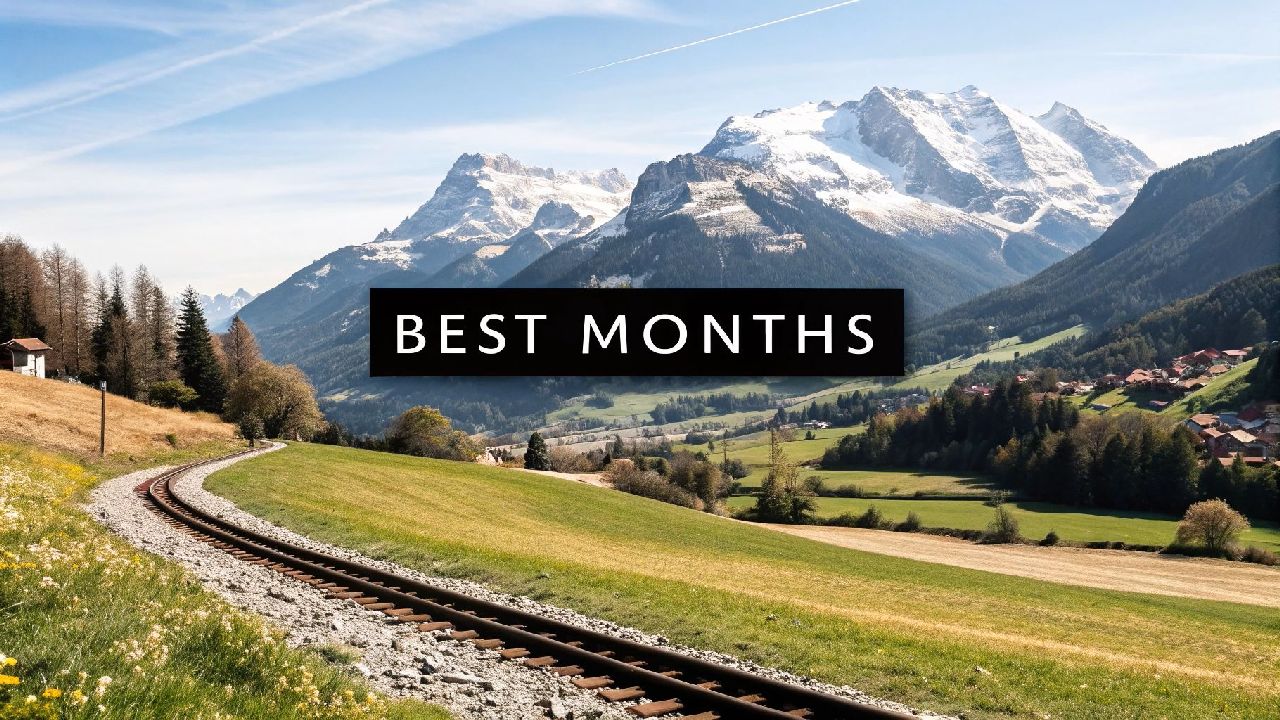Ready to Explore Switzerland? Pick the Perfect Month!
Planning a trip to Switzerland? Knowing the best months to visit Switzerland is crucial for a truly memorable experience. This guide helps you choose the ideal time for your perfect Swiss adventure, whether you’re an independent traveler seeking solo exploration, a female traveler prioritizing safe and social experiences, an adventure enthusiast craving outdoor thrills, a culture buff eager to dive into local life, or a budget-conscious explorer looking for cost-effective options.
From hiking amidst wildflowers to exploring Christmas markets, discover the magic of Switzerland during its most enchanting months: May, June, July, August, September, October, and December.
1. May: pleasant weather and blooming landscapes
May is a fantastic month to experience Switzerland if you’re looking for the sweet spot between pleasant weather, blooming landscapes, and fewer crowds. This shoulder season month marks the transition from spring to early summer, offering a unique blend of vibrant scenery and comfortable temperatures. As the snow begins to melt at lower elevations, it reveals lush green valleys carpeted with wildflowers and waterfalls roaring with renewed vigor.
While higher altitudes might still be snow-capped, many mountain passes and hiking trails start to reopen, providing opportunities for early-season exploration. May also presents excellent value, with lower accommodation rates than the peak summer months and a more authentic Swiss experience as locals haven’t yet started their summer holidays. This makes it one of the best months to visit Switzerland for those seeking a balance of affordability and accessibility.

For a quick reference, here are the key takeaways about visiting Switzerland in May: blooming spring flowers, fewer tourists, milder temperatures (15-20°C/59-68°F in lowlands), reopening mountain passes and trails, and lower accommodation costs. This combination of factors makes May especially appealing to budget travelers and nature photographers. As the infographic highlights, May offers a balance between comfortable weather and accessibility to a range of activities, from hiking to exploring charming towns and villages.
 May’s charm extends beyond its natural beauty. The month is dotted with cultural events and festivals, providing a glimpse into local traditions. From Ascension Day and Whitsun holiday celebrations to Geneva’s Fête de la Danse and Basel’s International Museum Day events, there’s something for everyone.
May’s charm extends beyond its natural beauty. The month is dotted with cultural events and festivals, providing a glimpse into local traditions. From Ascension Day and Whitsun holiday celebrations to Geneva’s Fête de la Danse and Basel’s International Museum Day events, there’s something for everyone.
Smaller towns also come alive with spring festivals, offering immersive cultural experiences. For those seeking tranquility, early-season boat cruises on major lakes like Lake Geneva offer stunning views of the snow-capped Alps against a backdrop of blossoming landscapes. Learn more about May activities.
Pros:
- Lower accommodation rates than summer: Budget-conscious travelers can find excellent deals on hotels and other accommodations.
- Beautiful spring landscapes and flowers: Witness the Swiss countryside bursting with color as wildflowers bloom and trees blossom.
- Comfortable temperatures for sightseeing: Enjoy exploring towns, cities, and lower-altitude hiking trails in pleasant weather.
- Locals not yet on summer holidays: Experience a more authentic Swiss atmosphere in towns and villages.
- Authentic experiences in towns and villages: Interact with locals and discover the true charm of Switzerland’s smaller communities.
Cons:
- Higher elevation areas still have snow: While lower areas are accessible, some high-altitude trails and mountain passes may remain closed.
- Some mountain passes and trails not yet open: Check accessibility before planning high-altitude hikes.
- Increased chance of rainfall: Pack accordingly and be prepared for occasional showers.
- Some mountain facilities still closed early in month: Confirm the opening dates of cable cars, restaurants, and other mountain facilities.
- Weather can be unpredictable: Be prepared for variable temperatures and potential rain by packing layers.
Tips for Visiting Switzerland in May:
- Check opening dates for mountain attractions: Ensure your desired hiking trails, cable cars, and mountain restaurants are open.
- Book accommodations 1-2 months in advance: Secure the best rates and availability, especially for weekends and holidays.
- Pack layers for variable temperatures: Be prepared for both warm sunshine and cooler mountain air.
- Consider lower-altitude hiking routes: Explore the numerous trails at lower elevations that offer stunning views of blossoming landscapes.
- Visit snow-free wine regions like Ticino or Lake Geneva: Indulge in wine tasting and vineyard tours in these beautiful regions.
May offers a compelling blend of natural beauty, cultural experiences, and affordability, making it a desirable time for a variety of travelers. Whether you’re a nature photographer seeking to capture the vibrant spring blooms, an adventure seeker looking for less crowded hiking trails, or a budget traveler searching for the best value, May is undoubtedly one of the best months to visit Switzerland. It’s a perfect time for independent solo travelers, female travelers seeking safe and enriching experiences, and culture enthusiasts wanting to immerse themselves in local traditions.
2. June: Switzerland’s Early Summer Bloom
June is arguably one of the best months to visit Switzerland, representing the sweet spot between pleasant weather and manageable crowds. As early summer unfolds, the country awakens with vibrant wildflowers blanketing meadows, and the snow begins to recede from higher altitudes, revealing breathtaking landscapes. This makes June an ideal time to experience Switzerland’s beauty before the peak tourist season hits in July and August. If you’re looking for the best months to visit Switzerland with a balance of accessibility and tranquility, June deserves serious consideration.
What Makes June Special?
June offers a unique combination of accessible attractions and relatively low visitor numbers. You can enjoy comfortable hiking conditions with fewer crowds on the trails and have a greater choice of accommodation without the premium prices of peak season. The days are long, offering ample time to explore, and the weather is generally warm and sunny, perfect for outdoor activities.
Features of a June Visit:
- Moderate Temperatures: Expect comfortable temperatures ranging from 18-23°C (64-73°F) in the lowlands, making it ideal for hiking and exploring cities.
- Long Daylight Hours: Maximize your sightseeing with extended daylight hours, allowing you to enjoy the scenery and activities well into the evening.
- Opening Mountain Facilities: Most mountain facilities, including cable cars and hiking trails, are open by mid-June, providing access to stunning alpine views.
- Lush Landscapes and Wildflowers: Witness the beauty of Switzerland’s alpine meadows bursting with colorful wildflowers.
- Lower Visitor Numbers: Experience a more relaxed atmosphere with fewer crowds compared to the peak summer months.
Pros:
- Better Accommodation Availability: Find a wider selection of accommodations with greater availability and potentially lower prices than in July or August.
- Excellent Hiking Conditions: Enjoy pristine hiking trails with fewer fellow hikers.
- Open Mountain Passes: Most mountain passes are open by mid-June, facilitating scenic drives and access to higher elevations.
- Fresh Alpine Lakes for Swimming: Take a refreshing dip in crystal-clear alpine lakes.
- Pleasant Outdoor Dining: Savor meals al fresco in the comfortable warmth of early summer evenings.
Cons:
- Lingering Snow: Some high-altitude trails might still have snow patches in early June, so check conditions before venturing out.
- Occasional Rainfall: Rain is slightly more frequent in June than in July, so packing layers and a rain jacket is recommended.
- Limited Mountain Restaurant Options: Some smaller mountain restaurants may not be fully operational until mid-June.
- Unpredictable Weather: Mountain weather can be unpredictable, so be prepared for changing conditions.
- Not All Summer Events Have Started: While some festivals occur in June, not all summer events will have commenced yet.
Examples of June Events:
- Art Basel: International art fair held in Basel (mid-June).
- Fête de la Musique: Music festival celebrating the summer solstice in Geneva (around June 21st).
- Zurich Pride Festival: A celebration of LGBTQ+ rights and culture in Zurich (mid-June).
- Local Wine Festivals: Various wine festivals take place in vineyard regions throughout Switzerland in June.
Tips for Traveling to Switzerland in June:
- Check Mountain Pass Conditions: Verify the opening dates of mountain passes if you plan to drive in the Alps.
- Book Accommodations in Advance: While availability is better than peak season, it’s still advisable to book accommodations 2-3 months in advance, especially if traveling on weekends.
- Pack Layers: Be prepared for varying temperatures by packing layers of clothing.
- Consider the Pre-Alps: Hiking trails in the Pre-Alps generally open earlier than those at higher altitudes.
- Look for Early Summer Deals: Take advantage of potential early summer special offers at resorts and hotels.
Who June is Perfect For:
June is a great time for various travelers, including:
- Independent solo travelers: Enjoy the freedom to explore at your own pace in less crowded conditions.
- Female travelers: Experience a safe and welcoming environment with ample opportunities to connect with other travelers.
- Adventure seekers: Take advantage of excellent hiking and outdoor activities with fewer crowds.
- Culture and history enthusiasts: Enjoy access to museums, historical sites, and local events.
- Budget-conscious explorers: Benefit from potentially lower prices on accommodations and travel compared to peak season.
June offers a delightful balance for experiencing Switzerland’s natural beauty and cultural attractions before the peak summer crowds descend. With careful planning and these tips, you can make the most of your June adventure in the Swiss Alps.
3. July: warm weather and long sunny days
July is arguably one of the best months to visit Switzerland if you’re seeking warm weather and long sunny days perfect for exploring the magnificent alpine landscapes. This month marks the peak of summer, offering ideal conditions for a variety of outdoor activities, from hiking amidst vibrant wildflowers to swimming in crystal-clear lakes. July also sees Switzerland come alive with numerous cultural festivals and events, adding another dimension to your Swiss adventure. This makes July a strong contender among the best months to visit Switzerland, particularly for those who love to be outdoors.

With temperatures averaging between 20-25°C (68-77°F) in the lowlands and maximum daylight hours, July allows you to maximize your time exploring. All mountain passes and hiking trails are open, providing access to breathtaking panoramic views. Imagine hiking through fields of wildflowers with snow-capped peaks as your backdrop – July makes this a reality.
Furthermore, all attractions, cable cars, and mountain railways are fully operational, giving you the freedom to explore even the highest peaks with ease. For adventure seekers, conditions are excellent for paragliding, mountain biking, and various water sports. Culture and history enthusiasts will also find plenty to enjoy, with events like the Montreux Jazz Festival (early July), Zermatt Folklore Festival, and various open-air cinema events and alpine cattle processions taking place throughout the country. Even the Swiss National Day celebrations, though on August 1st, add to the festive atmosphere at the end of the month.
Pros:
- Perfect weather for hiking, swimming, and outdoor dining.
- All attractions and mountain transportation options are operational.
- Spectacular mountain views with clear skies.
- Proximity to Swiss National Day festivities.
- Ideal conditions for paragliding, mountain biking, and water sports.
Cons:
- Peak tourist season means larger crowds and higher prices.
- Popular destinations can get crowded, requiring pre-booking for accommodations and attractions.
- Occasional afternoon thunderstorms can occur in the mountains.
Tips for July Travel in Switzerland:
- Book accommodations well in advance (3-4 months minimum): This is especially crucial for solo travelers and budget-conscious explorers who might have fewer options if booking late.
- Start hikes early: Beat the crowds and potential afternoon storms. This also allows female travelers to feel safer on less-traveled trails.
- Utilize the Swiss Travel Pass: This provides unlimited travel on public transportation, an excellent option for budget-conscious travelers and those exploring multiple regions.
- Consider less touristy villages: Staying near, but not directly in, major destinations can offer a more authentic experience with smaller crowds and potentially lower prices.
- Pack layers, sun protection, and rain gear: Mountain weather can be unpredictable, even in July.
July’s vibrant landscapes, accessible mountain trails, and abundance of cultural events make it a compelling choice for many travelers. However, being prepared for the peak season crowds and higher prices is essential for a smooth and enjoyable Swiss adventure. Whether you’re an independent traveler seeking solitude in nature, a female traveler looking for safe and enriching experiences, or an adventure-seeker eager to explore the Alps, July offers something for everyone willing to embrace the summer bustle.
4. August: the busiest month
August is a peak month to visit Switzerland, offering a quintessential summer experience with warm weather and a vibrant atmosphere. If you’re considering Switzerland in August, it’s important to weigh the pros and cons as it’s one of the best months to visit Switzerland, yet also the busiest.
This month represents high summer in the Swiss Alps and lowlands. Expect reliably warm temperatures ranging from 20-25°C (68-77°F) in the lowlands, making it ideal for swimming in the lakes and enjoying outdoor activities. The extended daylight hours allow for maximum exploration and the mountain infrastructure operates at full capacity, opening up a world of hiking trails and scenic vistas. August is particularly popular with families due to school holidays across Europe, contributing to a bustling atmosphere.
Features:
- Warm temperatures (20-25°C/68-77°F in lowlands)
- Long daylight hours
- All mountain facilities fully operational
- Lakes warm enough for comfortable swimming
- Numerous outdoor festivals and events
Pros:
- Reliable weather for outdoor activities, including swimming and sunbathing
- Perfect conditions for high-altitude hiking with accessible trails
- Vibrant atmosphere in tourist destinations, offering exciting social opportunities
- Swiss National Day celebrations (August 1st), a unique cultural immersion
- Excellent conditions for water sports on lakes, from kayaking to paddleboarding
Cons:
- Peak tourist season with maximum crowds, impacting spontaneity
- Highest accommodation prices of the year, requiring careful budgeting
- Popular spots can feel overcrowded, potentially diminishing enjoyment
- Advance reservations essential for most activities, demanding pre-planning
- Some locals on vacation, potentially affecting smaller businesses and services
Examples of August Events:
- Locarno Film Festival: A prestigious international film festival.
- Lucerne Festival for classical music: A renowned classical music event.
- Street Parade in Zurich: A vibrant electronic music festival and parade.
- Swiss National Day fireworks displays: Celebrated nationwide on August 1st.
- Outdoor cinema events across the country: Enjoying films under the stars.
Tips for Visiting Switzerland in August:
- Book accommodations 4-5 months in advance: Secure your preferred lodging and manage your budget effectively.
- Make restaurant reservations for popular establishments: Avoid disappointment and ensure a smooth dining experience.
- Consider day trips to less-known destinations: Escape the crowds and discover hidden gems for a more tranquil experience.
- Use early morning hours for popular attractions to avoid crowds: Maximize your time and enjoy a more relaxed visit.
- Take advantage of regional transportation passes: Cost-effective travel and convenient access to various destinations.
Why August Deserves Its Place on the List:
 Despite the crowds, August’s reliably warm weather and the full operation of mountain facilities make it a prime time for outdoor enthusiasts, particularly hikers and those seeking water activities. The abundance of festivals and events adds a vibrant cultural dimension, providing an exciting experience for those seeking more than just scenic beauty.
Despite the crowds, August’s reliably warm weather and the full operation of mountain facilities make it a prime time for outdoor enthusiasts, particularly hikers and those seeking water activities. The abundance of festivals and events adds a vibrant cultural dimension, providing an exciting experience for those seeking more than just scenic beauty.
While it requires meticulous planning, August in Switzerland offers a fulfilling experience for those willing to navigate the peak season. However, budget-conscious travelers and those seeking solitude might find other months more suitable. Independent travelers, especially female travelers seeking safety, might find the crowded environment reassuring due to the constant presence of other people. Adventure seekers have access to all hiking trails and excursions, while culture and history buffs will appreciate the vibrant atmosphere and the Swiss National Day celebrations.
5. September: A Golden Opportunity Among the Best Months to Visit Switzerland
September is arguably one of the best months to visit Switzerland, offering a magical shoulder season experience. As summer’s crowds disperse and the vibrant hues of autumn begin to paint the higher elevations, you’ll find a sweet spot of comfortable temperatures, stunning scenery, and significantly reduced prices. This makes it an ideal time for budget-conscious explorers, independent travelers, and photography enthusiasts seeking an enriching and less crowded Swiss adventure.
The Magic of Shoulder Season
September in Switzerland bridges the gap between summer and autumn, providing near-perfect weather conditions without the summer rush. The lowlands bask in pleasant temperatures averaging 15-20°C (59-68°F), perfect for exploring cities and embarking on leisurely hikes. Meanwhile, the mountains begin their transformation into a breathtaking tapestry of golds, reds, and oranges, offering spectacular photo opportunities. This transition also means fewer crowds at major attractions, allowing for a more immersive and peaceful experience, something particularly valued by independent solo travelers and those seeking self-exploration.
Features and Benefits:
- Pleasant temperatures: Enjoy comfortable daytime temperatures ideal for hiking and exploring.
- Early autumn colors in mountains: Witness the stunning transformation of the alpine landscape.
- Reduced crowds at major attractions: Experience iconic locations without the summer throngs, a plus for female travelers prioritizing safety and less crowded environments.
- Clear mountain views: Crisp air and fewer clouds make for breathtaking panoramic vistas.
- Harvest festivals and traditions: Immerse yourself in authentic Swiss culture during the vibrant harvest season, perfect for culture and history enthusiasts.
Pros:
- Significantly lower accommodation prices than summer months: A huge benefit for budget-conscious explorers.
- Excellent hiking conditions with fewer crowds: Ideal for adventure seekers and those looking for solitude on the trails.
- Most summer attractions still open: Enjoy the full range of activities and experiences.
- Beautiful photography opportunities with changing foliage: Capture the magic of autumn in the Swiss Alps.
- Authentic cultural experiences during harvest season: Engage with local traditions and celebrations.
Cons:
- Days getting shorter: Be prepared for less daylight than in the summer months.
- Mountain restaurants and cable cars may begin reducing operation hours: Check schedules in advance to avoid disappointment.
- Some mountain passes may close with early snowfall: Flexibility is key for mountain excursions.
- Cooler evenings requiring warmer clothing: Pack layers to adapt to changing temperatures.
- Some smaller attractions may begin seasonal closures: Research opening times before your trip.
Examples of September Experiences:
- Alpabzug/Désalpe cattle descent ceremonies: Witness the colorful tradition of cows returning from the alpine pastures.
- Wine harvest festivals in Lake Geneva region: Indulge in local wines and festivities.
- Swiss Food Festival in Zermatt: A culinary delight for food lovers.
- Autumn markets in various towns: Discover local crafts and produce.
- Less crowded visits to iconic locations like Jungfraujoch: Enjoy the “Top of Europe” with fewer people.
Tips for September Travel in Switzerland:
- Book accommodations 1-2 months in advance: Secure the best deals and availability, especially if traveling during peak harvest festival times.
- Pack layers for varying temperatures: Be prepared for warm days and cooler evenings.
- Check operating schedules for mountain transportation: Cable cars and mountain trains may have reduced hours.
- Consider hiking at lower elevations later in the month: Conditions may be more favorable as snow starts to fall at higher altitudes.
- Take advantage of shoulder season deals at luxury hotels: Enjoy a touch of luxury at a more affordable price.
September in Switzerland caters to a variety of travel styles, from independent solo travelers and female adventurers seeking safe and enriching experiences to budget-conscious explorers, culture enthusiasts, and hikers looking for optimal conditions. By understanding the nuances of this shoulder season, you can plan a truly unforgettable Swiss adventure.
6. October: fewer crowds
October is arguably one of the best months to visit Switzerland if you’re seeking a blend of vibrant natural beauty, cultural immersion, and fewer crowds. This month offers a uniquely authentic Swiss experience before the onset of winter, making it ideal for budget travelers and those who prefer a more tranquil exploration of the country. For those considering when are the best months to visit Switzerland, October deserves serious consideration.
October showcases Switzerland’s spectacular autumn colors, particularly in the forested regions and vineyards that paint the landscape in hues of gold, crimson, and russet. Crisp, clear days provide stunning views of the mountains, making it a photographer’s paradise. The harvest season brings a plethora of local festivals celebrating wine and food, offering a glimpse into Switzerland’s rich cultural heritage. Imagine yourself wandering through a vibrant market, sampling local delicacies, and witnessing traditional celebrations – October provides just that.
Features:
- Moderate temperatures (10-15°C/50-59°F in lowlands)
- Spectacular autumn foliage
- Clear mountain views on sunny days
- Harvest and wine festivals
- Significantly reduced tourist crowds
Pros:
- Beautiful autumn colors perfect for photography
- Lower accommodation prices compared to peak season
- Authentic local experiences with fewer tourists
- Pleasant hiking weather at lower elevations
- Wine and food festivals celebrating harvest season
Cons:
- Some mountain facilities begin closing mid-month, limiting higher-elevation activities.
- Cooler temperatures requiring warmer clothing – pack layers!
- Earlier sunsets limiting daylight hours for activities.
- Possibility of early snow at higher elevations, especially later in the month.
- Some tourist attractions may operate on reduced hours.
Examples of October Events:
- Lugano Autumn Festival
- Basel Autumn Fair
- Chestnut festivals in Ticino
- Wine harvest celebrations in various regions
- Less crowded visits to popular attractions like Rhine Falls
Tips for an October Trip:
- Focus on lower-elevation activities later in the month: Hiking in the foothills, exploring cities, and visiting museums are excellent options.
- Check operating schedules for mountain transportation: Cable cars and cogwheel railways may have reduced schedules or closures. Learn more about October and transportation options within the country.
- Pack layers for variable temperatures: Be prepared for warm sunny days and cool evenings or higher altitudes.
- Consider city-based trips with day excursions: This allows for flexibility and access to amenities while still experiencing the beauty of the surrounding countryside.
- Enjoy local seasonal specialties: Indulge in game dishes, new wine, and roasted chestnuts for a true taste of autumn in Switzerland.
October is particularly appealing to various traveler types. Photographers will find endless inspiration in the stunning fall foliage. Culinary tourists will delight in the harvest traditions and abundance of seasonal food and wine. Hiking enthusiasts can enjoy optimal conditions at lower elevations. For the budget-conscious explorer, October’s shoulder season rates offer significant savings on accommodation, making it a cost-effective time to experience Switzerland. Independent solo travelers and female travelers will appreciate the quieter atmosphere and safe environment. If you seek freedom and self-exploration while immersing yourself in local culture, October provides the perfect backdrop for your Swiss adventure.
7. December: winter wonderland experience
December is one of the best months to visit Switzerland if you’re seeking a quintessential winter wonderland experience. This month transforms the country into a festive spectacle, with Christmas markets twinkling in medieval squares, snow-dusted chalets perched on mountainsides, and a palpable sense of holiday magic in the air. December offers a unique blend of cultural experiences, winter sports opportunities, and festive cheer, making it a truly special time to explore Switzerland.

For culture and history enthusiasts, December offers a chance to witness unique Swiss holiday traditions. From St. Nicholas Day celebrations on December 6th to the enchanting Luminara festival in the Ticino region, you’ll find immersive local experiences that delve deep into Swiss culture.
The Christmas markets, such as those in Zurich, Basel, and Montreux, offer a glimpse into local craftsmanship and culinary delights, while the beautifully decorated cities and towns provide a charming backdrop for exploration. Budget-conscious travelers can often find better deals on flights and accommodation earlier in December, before the peak Christmas and New Year rush.
Adventure seekers will rejoice at the start of the ski season in December. While not all resorts may be fully open, early season skiing often means fresh powder and fewer crowds compared to the peak season in February. Learn more about December and the top skiing destinations. For independent solo travelers, and especially female travelers, the festive atmosphere and generally safe environment in Switzerland provide a comfortable setting for self-exploration.
Features:
- Cold temperatures (0-5°C/32-41°F in lowlands, below freezing in mountains)
- Christmas markets and decorations
- Ski season beginning
- Festive atmosphere in cities and villages
- Winter sports opportunities
Pros:
- Magical Christmas atmosphere
- Beginning of ski season with possible fresh powder
- Beautifully decorated cities and towns
- Fewer crowds than February (peak ski season)
- Traditional Swiss holiday experiences
Cons:
- Short daylight hours
- Cold temperatures requiring proper winter gear
- Higher prices during Christmas and New Year weeks
- Some smaller attractions closed for winter
- Weather can disrupt travel plans
Tips for December Travel in Switzerland
- Book accommodations 3-4 months in advance, especially if traveling during the holiday weeks.
- Pack proper winter clothing, including waterproof boots, a warm hat, gloves, and scarf. Layering is key!
- Consider travel insurance for potential weather disruptions.
- Visit Christmas markets in the evenings for the most magical atmosphere.
- Check ski resort opening dates and snow conditions if planning a ski holiday.
December truly offers something for everyone, from the thrill of hitting the slopes to the charm of exploring festive markets. By understanding the advantages and disadvantages of traveling during this month, and by planning ahead, you can maximize your experience and create unforgettable memories in the Swiss winter wonderland.
Top 7 Months to Visit Switzerland Comparison
| Month | Implementation Complexity 🔄 | Resource Requirements ⚡ | Expected Outcomes 📊 | Ideal Use Cases 💡 | Key Advantages ⭐ |
|---|---|---|---|---|---|
| May | Moderate – some mountain passes and facilities closed | Moderate – layers, advance booking advised | Comfortable sightseeing weather, fewer tourists, spring blooms | Budget travel, authentic local experiences | Lower accommodation rates, beautiful spring landscapes |
| June | Moderate – most mountain passes open mid-month | Moderate – early summer special offers available | Good hiking conditions, long daylight, pre-peak tourism | Outdoor activities, art and cultural festivals | Mostly open attractions, pleasant outdoor dining |
| July | High – all facilities fully operational, pre-booking essential | High – early booking required, crowded spots | Peak summer vibrancy, full access to attractions | Peak summer tourism, festivals, alpine adventures | Perfect weather, maximum activities, top events |
| August | High – peak tourist season, advance reservations needed | High – highest prices and crowds | Reliable warm weather, fully operational mountain infrastructure | Family vacations, festivals, high-altitude hiking | Vibrant atmosphere, excellent conditions for water sports |
| September | Moderate – some seasonal closures begin | Moderate – good deals on accommodations | Lower crowds, autumn colors, harvest festivals | Shoulder season deals, photography, hiking | Significantly lower prices, beautiful foliage |
| October | Moderate – reduced daylight, some facility closures | Low to moderate – less crowded, shoulder season rates | Spectacular autumn colors, fewer tourists | Autumn foliage trips, culinary and harvest events | Lower accommodation prices, authentic experiences |
| December | High – winter conditions, holiday season planning | High – winter gear and advance booking required | Festive Christmas atmosphere, ski season start | Winter sports, holiday markets, festive traditions | Magical holiday mood, ski opportunities |
Your Swiss Adventure Awaits: Start Planning Today!
Finding the best months to visit Switzerland depends entirely on your travel style and priorities. From the blooming meadows of May to the crisp air of October, and the festive charm of December, each month offers a unique perspective on this stunning country.
 Whether you’re drawn to the hiking trails bursting with wildflowers in June, the pleasant warmth of July and August ideal for lake cruises, or the golden hues of September perfect for capturing breathtaking photos, there’s a perfect time for you to experience Switzerland. For budget-conscious travelers, shoulder seasons like May, June, September, and October offer a sweet spot with pleasant weather and fewer crowds compared to the peak summer months.
Whether you’re drawn to the hiking trails bursting with wildflowers in June, the pleasant warmth of July and August ideal for lake cruises, or the golden hues of September perfect for capturing breathtaking photos, there’s a perfect time for you to experience Switzerland. For budget-conscious travelers, shoulder seasons like May, June, September, and October offer a sweet spot with pleasant weather and fewer crowds compared to the peak summer months.
Remember that the best months to visit Switzerland are subjective. If you’re a winter sports enthusiast, December is ideal for hitting the slopes. If you’re after vibrant cultural experiences, consider the summer months when festivals abound. And for those seeking tranquility and fewer crowds, the shoulder seasons offer a peaceful escape.
Mastering the art of planning your trip based on the best months to visit Switzerland will empower you to make the most of your adventure. Whether you’re a solo female traveler prioritizing safety, an adventure seeker yearning for thrilling excursions, a culture enthusiast eager for immersive local experiences, or a budget-conscious explorer seeking cost-effective options, understanding seasonal nuances allows you to tailor your trip to your specific needs. Your Swiss adventure awaits!

Hi, I’m Laura — a travel writer with a thing for Switzerland and Central Europe. I write practical, down-to-earth guides that help people get the most out of their trips, whether they’re navigating mountain trains in the Alps or finding the best cafés in small Czech towns. I’m based in Zurich, but I’m often on the road, notebook in hand, chasing great views, good food, and local stories. My goal? To make travel feel less overwhelming and way more fun.






